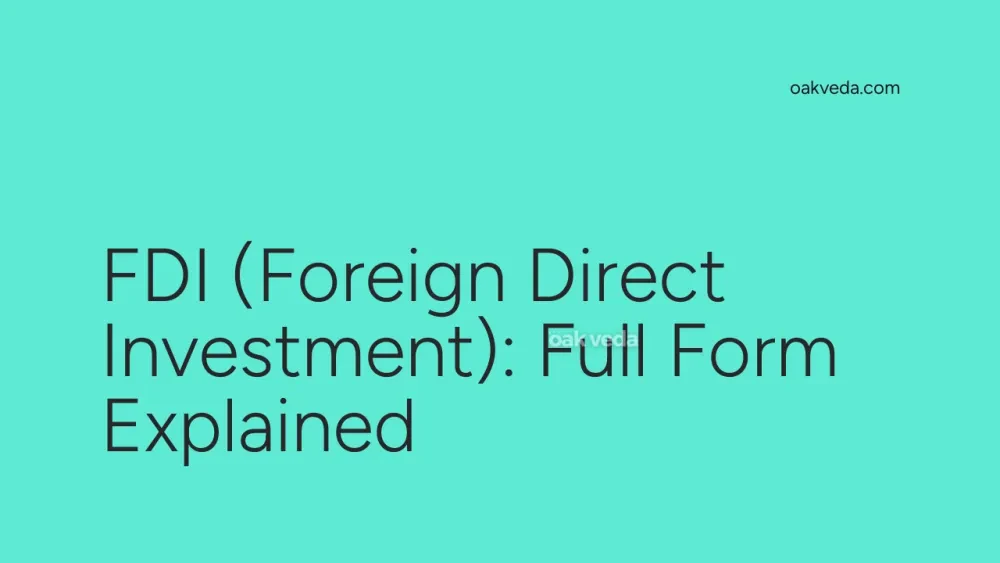
What is the Full Form of FDI?
The full form of FDI is Foreign Direct Investment. This term is widely used in the realm of international economics and business to describe a specific type of cross-border investment.
What is Foreign Direct Investment?
Foreign Direct Investment refers to an investment made by an individual or a company based in one country into a business or entity located in another country. This investment typically involves establishing ownership or control over the foreign enterprise, which distinguishes it from other forms of international investment, such as portfolio investments.
Origin and Development of Foreign Direct Investment
The concept of FDI has been around for centuries, with early examples dating back to the colonial era. However, it gained significant prominence in the post-World War II period as global trade expanded and economies became more interconnected. The development of FDI has been closely tied to the growth of multinational corporations and the increasing globalization of business operations.
How does Foreign Direct Investment work?
FDI works by allowing foreign investors to establish a lasting interest in a business entity in another country. This can be achieved through various means:
- Establishing a new enterprise in the host country (Greenfield investment)
- Acquiring an existing company (Mergers and Acquisitions)
- Expanding operations of an existing foreign company (Brownfield investment)
- Forming a joint venture with a local company
The investor typically seeks to gain a significant degree of influence over the management of the enterprise, which is usually defined as owning at least 10% of the voting power.
Types of Foreign Direct Investment
FDI can be categorized into several types:
- Horizontal FDI: When a company establishes the same type of business operation in a foreign country as it operates in its home country.
- Vertical FDI: When a company invests in businesses that are at different stages of the supply chain in a foreign country.
- Conglomerate FDI: When a company invests in an unrelated business in a foreign country.
Functions of Foreign Direct Investment
FDI serves several important functions in the global economy:
- Facilitates the transfer of capital across borders
- Promotes technology and knowledge transfer
- Enhances economic integration between countries
- Stimulates competition in domestic markets
- Contributes to economic growth and development
Applications of Foreign Direct Investment
FDI is applied across various sectors and industries, including:
- Manufacturing
- Services (e.g., finance, telecommunications)
- Natural resources extraction
- Real estate
- Technology and innovation
Features of Foreign Direct Investment
Key features of FDI include:
- Long-term commitment to the host country
- Significant control or influence over the foreign enterprise
- Transfer of tangible and intangible assets
- Exposure to local market conditions and regulations
- Potential for higher returns compared to portfolio investments
Benefits of Foreign Direct Investment
FDI offers numerous benefits to both the host country and the investing entity:
For the Host Country:
- Job creation
- Inflow of new capital
- Increase in foreign exchange reserves
- Introduction of new skills and technologies
- Economic growth and increased tax revenues
- Access to global markets
For the Investing Entity:
- Access to new markets
- Potential for cost reduction through lower wages or resource costs
- Diversification of business operations
- Competitive advantage in global markets
Limitations or Challenges of Foreign Direct Investment
Despite its benefits, FDI also faces several challenges:
- Political and regulatory risks in host countries
- Cultural differences and language barriers
- Potential for economic exploitation concerns
- Risk of capital flight during economic downturns
- Possible negative impacts on local businesses due to increased competition
Future Developments in Foreign Direct Investment
The landscape of FDI is continually evolving, influenced by factors such as:
- Technological advancements, particularly in digital and green technologies
- Changing global economic patterns and emerging markets
- Shifts in government policies and international agreements
- Increasing focus on sustainable and responsible investment practices
As the global economy becomes more interconnected, FDI is likely to play an even more significant role in shaping international business and economic development.
FAQs on FDI Full Form
-
What is the minimum ownership percentage for an investment to be considered FDI? Generally, an ownership of at least 10% of the voting power is considered FDI.
-
How does FDI differ from portfolio investment? FDI involves a lasting interest and control in a foreign enterprise, while portfolio investment typically involves purchasing securities without control over the entity.
-
Can individuals engage in FDI? Yes, while most FDI is conducted by companies, individuals can also make foreign direct investments.
-
What are some examples of major FDI projects? Examples include Toyota's manufacturing plants in the United States, Vodafone's investments in India's telecom sector, and Chinese investments in African infrastructure projects.
-
How do countries attract FDI? Countries often offer incentives such as tax breaks, subsidies, and special economic zones to attract foreign direct investment.
In conclusion, Foreign Direct Investment, the full form of FDI, plays a crucial role in the global economy by facilitating cross-border capital flows and fostering economic growth. As businesses continue to expand internationally, understanding FDI and its implications becomes increasingly important for investors, policymakers, and economic analysts alike.
You may be interested in:

